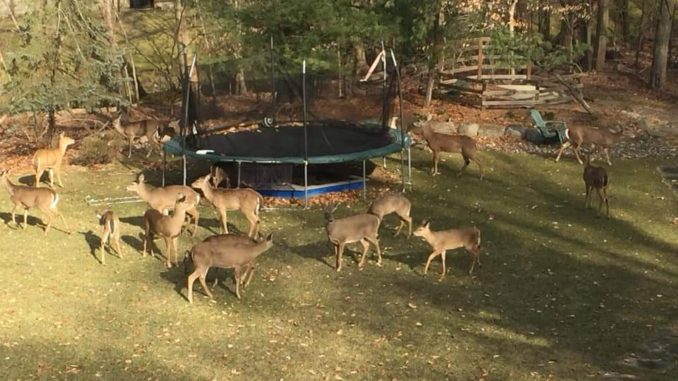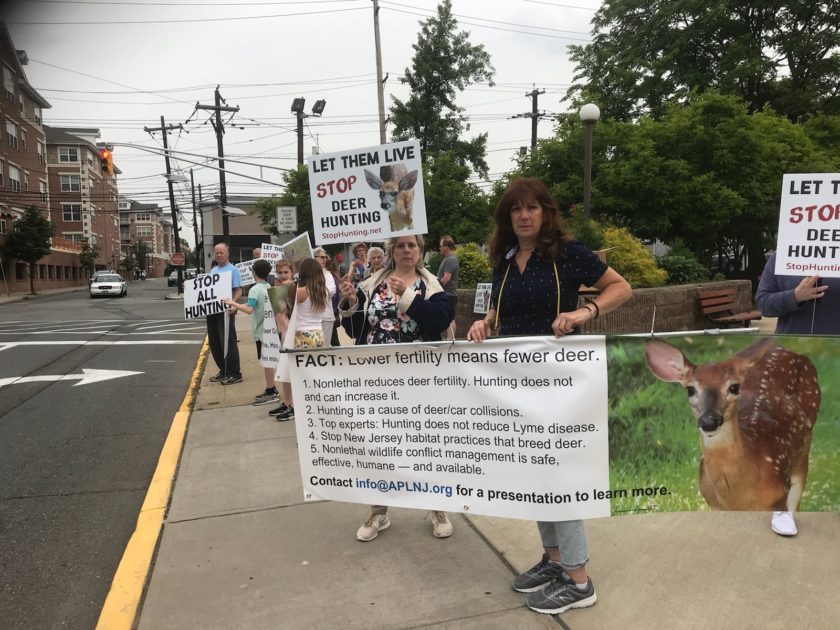
NORTHERN VALLEY AREA, N.J.—While a regional approach to deer population control remains a major theme among Pascack and Northern valley municipalities—save for Saddle River and River Vale now planning fall 2019 bowhunts—managers of several area nature sanctuaries warn that an overpopulation of deer is causing long-term impacts to forests and biodiversity—and they are taking action.
For most North Jersey mayors and public officials, however, deer population reduction means taking on anti-hunting activists and in most cases, deciding to do nothing and see if the problem eventually goes away on its own.
Most North Jersey nature centers and sanctuaries have already taken action—at three nature preserves managers have built deer-excluding fences to help protect and regenerate forest understory generally decimated by an overpopulation of deer.
Such exclosures were built at Flat Rock Brook in Englewood, Greenbrook Sanctuary in Palisades Interstate Park, and one is currently being installed at Closter Nature Center.
Each of the centers’ deer exclusion fences only protects a portion of their nature preserve, allowing deer to continue to roam freely and browse a large swath of forest.
At Flat Rock Brook, deer are excluded from 90 of 150 acres, about 30 of 150 acres at Closter Nature Center, and portions of Greenbrook Nature Sanctuary, a 165-acre preserve spanning Alpine and Tenafly.
The nature center managers say that action is needed to exclude deer to try to allow the forest understory a chance to regenerate itself, providing opportunities for native plants and species to repopulate the forest and sustain the long-term health of an ecosystem seriously threatened by an overpopulation of deer.
Most nature center managers note the abundance of deer—with no natural predators since wolves and mountain lions are no longer here—have only two threats to thin growing numbers: death by cars and severely cold winters.
And only two municipalities in Bergen currently are pursuing lethal bowhunts to thin local herds. Saddle River officials are moving forward with a second annual bowhunt in 2019 after it culled 135 deer during its 2018 bowhunt. Also, River Vale’s mayor and council are planning for a fall 2019 bowhunt, coordinating planning with state Fish and Wildlife officials.
River Vale’s mayor and council have said that they fear a car-deer collision leading to a fatality, after watching deer-automobile incidents increase in 2018 to nearly 50 incidents.
A recent drone survey in River Vale found 96 deer per-square-mile, far exceeding an average of 10 deer per-square-mile that an area can sustain, say biologists and naturalists.
One naturalist’s view
Closter Nature Center Director Marc Gussen, who has worked at the center for two decades, said he has seen the destruction wreaked by deer on the preserve’s forests, young native oak tree saplings and native plants grow worse and worse over the years.
“I’ve been watching the decline of forests here and we needed to take action now,” said Gussen.
Gussen said that the forest understory supports not only future forest regeneration but native bird species, insects and an entire ecosystem that is being altered and which is likely to disappear entirely without intervention.
He said deer overpopulation will cause irreparable negative impacts on area nature preserves and ecology if left to continue. “We have an obligation to our communities to protect our forests and their health,” Gussen said.
Deer damage ‘far worse’
“We just cannot let nature take its course. The damage (done) to the forest by deer is far worse than if we let someone in to do whatever they wanted,” he said.
“We are doing permanent damage to our forests in North Jersey due to deer browsing and destruction,” he said.
Asked about possible solutions whether lethal, non-lethal or educational, Gussen said “deer population has to come down” and noted besides cars and cold winters to reduce deer population, the only other “controls” on population are food supply and natural predators—neither of which reduce deer numbers in North Jersey.
Gussen noted food for deer is abundant in suburban landscapes and no natural predators are around to reduce deer populations.
For Gussen, who said he empathizes with and appreciates the compassion of animal-rights and anti-hunting activists, only some form of hunting can reduce deer numbers that have grown so rapidly in North Jersey.
He said most non-lethal methods are ineffective to reduce deer population.
‘Balance…with science’
“Most of the other methods besides hunting are not working” to reduce deer population, he said. “While I applaud their [activists’] compassion, I need to balance emotions with science. Compassion without science can lead us astray,” said Gussen.
Gussen said North Jersey and Bergen County “needs to make a decision as a region” what it wants to do about deer overpopulation impacts. Doing nothing due to possible political repercussions or “bad press” only increases the negative ecological impacts from deer overpopulation, he said.
“The bottom line is dozens and dozens of bird and insect species are being wiped out because of deer numbers,” said Gussen. “If all you had were deer left and everything else was extinct, is that what you’d want?” he asked.
“It’s not about the deer. It’s about [ecosystem] diversity,” he said.

Bowhunts ‘help plant seed’
Gussen said the two planned hunts in Saddle River and River Vale “are potentially just a drop in the bucket” but their success in reducing deer population “can help plant the seed” for other communities to pursue deer-reduction strategies.
Marin Moore, a Closter Nature Center summer program administrator, said the exclosure fences—eight-foot-high plastic fences—keep the deer from eating the forest understory of oak saplings trying to germinate.
Moore said many native species are also eaten by browsing deer “and the big impact from deer is the native species don’t grow and cannot grow” leading to invasive species taking over a forest’s vegetation, altering and reducing its species diversity.
Other views
James Hall, superintendent, Palisades Interstate Park Commission, said the interstate park’s New Jersey side consists of 2,500 acres of parkland and while no hard data on deer numbers exists, he said observations indicate not a lot of deer due to Palisades Interstate Parkway criss-crossing the area and rocky, unforested cliff faces.
However, its lone nature preserve, Green Brook Sanctuary, did install a deer exclosure fence to prevent deer browsing.
Meanwhile, Tenafly Nature Center, parts of which run contiguous with interstate park land, does not appear to have a huge problem with deer browsing though deer were excluded from the center’s approximate 500-square-foot butterfly garden to protect its plantings, said Director Peter Punzi Aug. 7.
Punzi said while other nature centers are nearer residential areas, Tenafly’s center is adjacent to the interstate park and deer are free to roam there and may also face pressure from a larger coyote population, helping to keep down deer numbers.
“Deer are always here and we always get deer browsing, but we’re not seeing the kind of deer [damage] that the other [preserves] are seeing,” he observed.
He theorized that nature centers closer to residential neighborhoods where food sources are more plentiful may be prone to have deer come and go more frequently, causing more damage.
Anti-hunting county
At an April county League of Municipalities meeting, Upper Saddle River Mayor Joanne Minichetti told 20 North Jersey mayors that Bergen is only one of three counties statewide without a countywide deer culling strategy in place.
Due to strong anti-hunting sentiment in Bergen, most mayors prefer to take a wait-and-see approach to deer population control and hold out hope that a regional approach will somehow materialize.
At a June 5 Englewood forum billed as an opportunity for public officials to discuss a regional approach to deer management, several mayors expressed interest in holding follow-up sessions to discuss a regional approach but no follow-up meetings have occurred.
Although 20-plus towns attended the forum, little concrete action has resulted or been proposed since.
A state Fish and Wildlife agency director told public officials at the June 5 forum to take individual local actions to reduce deer numbers and not wait for a regional approach.
She said she’s heard officials talking about regional action for a half-dozen years with nothing to show for it.
On one hand, most mayors and public officials—and area residents—agree that deer are an all-too-frequent visitor to suburban yards, residential streets, parks and downtowns. Deer have even been seen in downtown Englewood.
On the other hand, there is little agreement among local leaders on what to do about it, including how to control them, what number is too many, whether lethal or non-lethal means should be employed and what reduction method is most effective.
Many public discussions come to a stalemate when experts or advocates present opposing views on deer impacts and methods to effect deer controls and population reduction.
Bergen County Director of Parks James J. Koth was not immediately available to discuss deer impacts on county parks and deer management.
Also, efforts to reach Englewood Mayor Michael Wildes and Lisa Wisotsky, city Deer Task Force chair, to determine next steps for regional forums on deer population control were not returned by press time.
